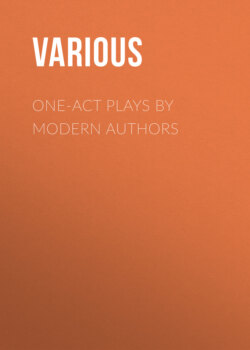Читать книгу One-Act Plays by Modern Authors - Various - Страница 8
На сайте Литреса книга снята с продажи.
THE IRISH NATIONAL THEATRE
ОглавлениеTable of Contents
About 1890 began the movement which has since been known as the Celtic Renaissance, a movement that had for its object the lifting into literature of the songs, myths, romances, and legends treasured for countless generations in the hearts of the Irish peasantry. In the same decade in Great Britain and on the Continent, tendencies were at work looking to the reform of the drama and its rescue from commercial formulas. The genesis of the Irish National Theatre, a pioneer in the field of repertory in Great Britain, and one of the first of the Little Theatres, is due to both of these influences.
Its first form was the Irish Literary Theatre, founded in 1899 by Edward Martyn, the author of The Heather Field and Maeve, George Moore, and William Butler Yeats. The first play produced by this organization was Yeats's Countess Cathleen. This enterprise employed only English actors, and did not assume to be purely national in scope. It came to an end in October, 1901. It was in October, 1902, that in Samhain, the organ of the Irish National Theatre, William Butler Yeats made the following announcement: "The Irish Literary Theatre has given place to a company of Irish actors." The nucleus of this new Irish National Theatre was certain companies of amateurs that W. G. Fay had assembled. These companies were composed of people who were unable to give full time to their interest in the drama, but who came from the office or the shop to rehearse at odd moments during the day and in the evening. The Irish National Theatre really developed from these amateur companies. It was strictly national in scope. The advisers, who were to include Synge, Lady Gregory, Padraic Colum, William Butler Yeats, and others, looked to the Irish National Theatre to bring the drama back to the people, to whom plays dealing with society life meant nothing. They intended also that their plays "should give them [the people] a quite natural pleasure, should either tell them of their own life, or of that life of poetry where every man can see his own magic, because there alone does human nature escape from arbitrary conditions." This program has been carried out with remarkable success.
October, 1902, is the date for the beginning of the Irish National Theatre. At first W. G. Fay, and his brother, Frank Fay, were in charge of the productions, the former as stage manager. Frank Fay had charge of training a company, in which the star system was unknown. He had studied French methods of stage diction and gesture, and the Irish Players are generally said to show the results of his familiarity with great French models. In 1913 a school of acting was (p. xxviii) organized in order to perpetuate the tradition created by the Fays.
Among the most famous playwrights who have written for the Irish National Theatre are Padraic Colum, John Millington Synge, William Butler Yeats, Lady Gregory, St. John G. Ervine, Æ (George W. Russell), and Lord Dunsany. At one time the theatre sent out, in a circular addressed to aspiring authors who showed promise, the following counsel: "A play to be suitable for performance at the Abbey should contain some criticism of life, founded on the experience or personal observation of the writer, or some vision of life, of Irish life by preference, important from its beauty or from some excellence of style, and this intellectual quality is not more necessary to tragedy than to the gayest comedy."[10]
In 1904 the Irish National Theatre was housed for the first time in its own playhouse, the Abbey Theatre. This change was made possible by the generosity of Miss A. E. F. Horniman, who saw the Irish Players when they first went to London in 1903. It was she who obtained the lease of the Mechanics' Institute in Dublin, increased its capacity, and rebuilt it, giving it rent free to the Players from 1904 to 1909, in addition to an annual subsidy which she allowed them. In 1910 the Abbey Theatre was bought from her by public subscription. The next year, the Irish Players paid their famous visit to the United States.
The Irish National Dramatic Company was organized as a protest against current theatrical practices. Its founders purposed to reform the various arts of the theatre. By encouraging native playwrights they hoped to do for the drama of Ireland what Ibsen and other writers had done for the drama in Scandinavian countries, where people go to the theatre to think as well as to feel. It was not intended in any sense that these new Irish players were to serve the purpose of propaganda; truth was not to be compromised in the service of a cause. Acting, too, was to be improved: redundant gesture was to be suppressed; repose was to be given its full value; speech was to be made more important than gesture. Yeats in particular had theories as to the way in which verse should be spoken on the stage; he advocated a cadenced chant, monotonous but not sing-song, for the delivery of poetry. The simplification of costume and setting was also included in their scheme, for both were to be strictly accessory to the speech and movement of the characters.
They have been faithful to their ideals. The performances at the Abbey Theatre continue, although from time to time certain of the most eminent actors of the company have withdrawn, some to migrate to America. Among the plays produced in 1919 and 1920 by the National Theatre Society at the Abbey Theatre are W. B. Yeats's The Land of Heart's Desire, G. B. Shaw's Androcles and the Lion, Lady Gregory's The Dragon, and Lord Dunsany's The Glittering Gate.
